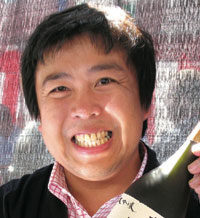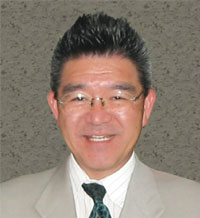Japanese cuisine that can truly satisfy your expectations
By Keiko Fukuda
The name of the store is well known. Many say that you can taste authentic Japanese food when you visit “Osawa” in Pasadena”. They offer a wide variety of menu items from sushi, shabu-shabu type items, to inexpensive items such as curry rice, and sukiyaki bowls at lunch time.
“I would like the customers to feel like they are in their own kitchen. A regular customer who feels that way, and wants to come as often as every day once asked me to purchase a table just for him. No one else can sit at the table even when he is not present? I cannot allow that.
I felt honored, but had to politely decline the request”, said the owner/chef, Shigefumi Tachibe. I heard that there are over 100 people who try, but not able to get in on weekends.
Chef Tachibe with a 40-year-long career is known as an executive chef who led the West Hollywood “Chaya Brasserie” to becoming a super popular restaurant after working for the Chaya Group for 30 years. Right after the Chaya Brasserie closed in July of 2015, Chef Tachibe transferred his main focus to “Osawa” completely. “Osawa” then had been managed by his wife, Sayuri, who is also the part owner, since its opening in 2013, and now the husband and the wife together are devoting themselves passionately to managing Osawa’s operation.
I have actually interviewed Chef Tachibe in the past while he was working for Chaya. He then told me how important the food ingredients were. He was going to farmer’s markets to select the vegetables with his own eyes. Now he moved from French to Japanese cuisine, but still maintains the same principle for the importance of ingredients.
“I select fish I buy myself, too. I go to the South Pasadena farmer’s market on Thursdays, and to the La Canada one on Saturdays. It is needless to say that we use fresh, organic, and safe ingredients for our customers. I change the “Daily Special” menu depending on what I bought for the day. So, every day is a new challenge for me,” says Chef Osawa.
His basic idea for creating the menu is just simply something he wants to eat himself. His idea is not only simple, but also flexible. “You can eat anything you feel is right. If you are treating your customers, you may want to order sushi, or shabu-shabu. If you come by just for a bite, you may want to order Oyako Donburi, or a bowl of Udon. There are no rules or styles you need to follow.” He stresses on the following belief: restaurants are supposed to offer safe ingredients, delicious foods, and of course, good hospitable service. He declares that Osawa’s chefs should be able to provide the closest possible dishes to whatever you request.
Next, I asked Sayuri about the customers in Pasadena. She said, “American and other non-Japanese Asian customers as well seek authentic Japanese food. They give us a comments like they feel as if they are in Japan in our restaurant. Also many Japanese customers visit Japan even more often than us, and thankfully, they also like our food.”
Lastly, I asked the Chef about his perspective for the next few years. He said, “I will carry on the same style for a while”. The main store remains the same, but they are planning to open the second store, which will be a casual delicatessen between the end of this year and the beginning of 2017. It is wonderful news for the Osawa fans.
期待に応えてくれる和食
その店の名は知れ渡っている。「パサデナの大沢に行けば、間違いのない和食が食べられる」と言う人は多い。寿司、しゃぶしゃぶから、ランチにはカレーやすき焼き丼など庶民的なメニューも楽しめる。実に幅が広い。
「お客様には自分の家のキッチンだと思ってほしいですね。毎日でも通いたいと言う常連さんから、席を自分専用に買わせてくれと熱心に頼まれたこともあります。しかし、それではその方がいらっしゃらない時に他のお客様が座ることができない。嬉しい言葉でしたが、もちろんお断りしました」と語るのはオーナーシェフの立部重文さんだ。週末には入店できない客が100人を超すとか。
立部シェフと言えば、料理人歴は40年、チャヤグループに30年以上勤め、チャヤブラッセリーのウエストハリウッド店を人気店に押し上げたエグゼクティブシェフとして知られた人物。2015年7月に同店がクローズした直後、立部シェフはその軸足を完全に大沢に移した。大沢は2013年の開店以降、シェフの妻で共同経営者の小百合さんが取り仕切っていたが、現在は夫婦共にその情熱を大沢に注いでいる。
実はチャヤ時代に立部さんには取材をしたことがあった。いかに料理は食材で決まるか、またそのために自分でファーマーズマーケットに足を運び、自分の目で野菜を選んでいるかを語っていた。そして、フレンチから日本食へとカテゴリーは変わっても、その食材重視のポリシーは変わっていなかった。
「魚も自分で選びますし、ファーマーズマーケットには木曜はサウスパサデナ、土曜はラキャナダに通います。フレッシュでオーガニック、お客様にとって安全な食材を使用するということ、これは当たり前のことです。仕入れた食材によってその日の『大沢スペシャル』を決めています。毎日がチャレンジですね」
また、メニューを考える時の基本の考えは非常にシンプル。「自分が食べたいと思うものをお客様にお出しする、それに尽きます」
立部シェフの考えはシンプルであると同時にフレキシブルでもある。「何を食べていただいてもいいんです。接待に使う時は寿司やしゃぶしゃぶ、でも一人でふらりと来たら親子丼でもうどんでもいい。美味しいものを食べるのにルールもスタイルも関係ありません」
安全な食材を使うのも美味しいのもレストランとしては当たり前のことだと強調する。そして、もてなしの心。大沢のシェフにリクエストを伝えれば、それに極力応じた料理を出すはずだと立部さんは明言する。
次にパサデナの顧客について小百合さんに聞いてみた。「アメリカ人でも日本人以外のアジア人のお客様でも、本当の和食を求めています。うちに来ると『日本に来たようだ』とおっしゃいます。また、日本人のお客様も私たち夫婦以上に頻繁に帰国されている方が多いのですが、おかげさまでご好評をいただいています」
最後にシェフに数年後の目標を聞くと「今のままずっと同じスタイルで続けていくこと」と語った。本店は今のまま続けていくが、同じパサデナ市内に2号店となるカジュアルなデリカテッセンを、2016年末から2017年頭にかけて開店させる予定とのこと。大沢ファンには嬉しいニュースだ。
Osawa
77 N. Raymond Avenue
Pasadena, CA 91103
626-683-1150
www.theosawa.com
Mon-Sun.11:30am-2:30pm
Sun.-Thu.5:00pm-9:30pm
Fri.&Sat.5:00pm-10:00pm
Everyday open
The name of the store is well known. Many say that you can taste authentic Japanese food when you visit “Osawa” in Pasadena”. They offer a wide variety of menu items from sushi, shabu-shabu type items, to inexpensive items such as curry rice, and sukiyaki bowls at lunch time.
“I would like the customers to feel like they are in their own kitchen. A regular customer who feels that way, and wants to come as often as every day once asked me to purchase a table just for him. No one else can sit at the table even when he is not present? I cannot allow that.
I felt honored, but had to politely decline the request”, said the owner/chef, Shigefumi Tachibe. I heard that there are over 100 people who try, but not able to get in on weekends.
Chef Tachibe with a 40-year-long career is known as an executive chef who led the West Hollywood “Chaya Brasserie” to becoming a super popular restaurant after working for the Chaya Group for 30 years. Right after the Chaya Brasserie closed in July of 2015, Chef Tachibe transferred his main focus to “Osawa” completely. “Osawa” then had been managed by his wife, Sayuri, who is also the part owner, since its opening in 2013, and now the husband and the wife together are devoting themselves passionately to managing Osawa’s operation.
I have actually interviewed Chef Tachibe in the past while he was working for Chaya. He then told me how important the food ingredients were. He was going to farmer’s markets to select the vegetables with his own eyes. Now he moved from French to Japanese cuisine, but still maintains the same principle for the importance of ingredients.
“I select fish I buy myself, too. I go to the South Pasadena farmer’s market on Thursdays, and to the La Canada one on Saturdays. It is needless to say that we use fresh, organic, and safe ingredients for our customers. I change the “Daily Special” menu depending on what I bought for the day. So, every day is a new challenge for me,” says Chef Osawa.
His basic idea for creating the menu is just simply something he wants to eat himself. His idea is not only simple, but also flexible. “You can eat anything you feel is right. If you are treating your customers, you may want to order sushi, or shabu-shabu. If you come by just for a bite, you may want to order Oyako Donburi, or a bowl of Udon. There are no rules or styles you need to follow.” He stresses on the following belief: restaurants are supposed to offer safe ingredients, delicious foods, and of course, good hospitable service. He declares that Osawa’s chefs should be able to provide the closest possible dishes to whatever you request.
Next, I asked Sayuri about the customers in Pasadena. She said, “American and other non-Japanese Asian customers as well seek authentic Japanese food. They give us a comments like they feel as if they are in Japan in our restaurant. Also many Japanese customers visit Japan even more often than us, and thankfully, they also like our food.”
Lastly, I asked the Chef about his perspective for the next few years. He said, “I will carry on the same style for a while”. The main store remains the same, but they are planning to open the second store, which will be a casual delicatessen between the end of this year and the beginning of 2017. It is wonderful news for the Osawa fans.
期待に応えてくれる和食
その店の名は知れ渡っている。「パサデナの大沢に行けば、間違いのない和食が食べられる」と言う人は多い。寿司、しゃぶしゃぶから、ランチにはカレーやすき焼き丼など庶民的なメニューも楽しめる。実に幅が広い。
「お客様には自分の家のキッチンだと思ってほしいですね。毎日でも通いたいと言う常連さんから、席を自分専用に買わせてくれと熱心に頼まれたこともあります。しかし、それではその方がいらっしゃらない時に他のお客様が座ることができない。嬉しい言葉でしたが、もちろんお断りしました」と語るのはオーナーシェフの立部重文さんだ。週末には入店できない客が100人を超すとか。
立部シェフと言えば、料理人歴は40年、チャヤグループに30年以上勤め、チャヤブラッセリーのウエストハリウッド店を人気店に押し上げたエグゼクティブシェフとして知られた人物。2015年7月に同店がクローズした直後、立部シェフはその軸足を完全に大沢に移した。大沢は2013年の開店以降、シェフの妻で共同経営者の小百合さんが取り仕切っていたが、現在は夫婦共にその情熱を大沢に注いでいる。
実はチャヤ時代に立部さんには取材をしたことがあった。いかに料理は食材で決まるか、またそのために自分でファーマーズマーケットに足を運び、自分の目で野菜を選んでいるかを語っていた。そして、フレンチから日本食へとカテゴリーは変わっても、その食材重視のポリシーは変わっていなかった。
「魚も自分で選びますし、ファーマーズマーケットには木曜はサウスパサデナ、土曜はラキャナダに通います。フレッシュでオーガニック、お客様にとって安全な食材を使用するということ、これは当たり前のことです。仕入れた食材によってその日の『大沢スペシャル』を決めています。毎日がチャレンジですね」
また、メニューを考える時の基本の考えは非常にシンプル。「自分が食べたいと思うものをお客様にお出しする、それに尽きます」
立部シェフの考えはシンプルであると同時にフレキシブルでもある。「何を食べていただいてもいいんです。接待に使う時は寿司やしゃぶしゃぶ、でも一人でふらりと来たら親子丼でもうどんでもいい。美味しいものを食べるのにルールもスタイルも関係ありません」
安全な食材を使うのも美味しいのもレストランとしては当たり前のことだと強調する。そして、もてなしの心。大沢のシェフにリクエストを伝えれば、それに極力応じた料理を出すはずだと立部さんは明言する。
次にパサデナの顧客について小百合さんに聞いてみた。「アメリカ人でも日本人以外のアジア人のお客様でも、本当の和食を求めています。うちに来ると『日本に来たようだ』とおっしゃいます。また、日本人のお客様も私たち夫婦以上に頻繁に帰国されている方が多いのですが、おかげさまでご好評をいただいています」
最後にシェフに数年後の目標を聞くと「今のままずっと同じスタイルで続けていくこと」と語った。本店は今のまま続けていくが、同じパサデナ市内に2号店となるカジュアルなデリカテッセンを、2016年末から2017年頭にかけて開店させる予定とのこと。大沢ファンには嬉しいニュースだ。
Osawa
77 N. Raymond Avenue
Pasadena, CA 91103
626-683-1150
www.theosawa.com
Mon-Sun.11:30am-2:30pm
Sun.-Thu.5:00pm-9:30pm
Fri.&Sat.5:00pm-10:00pm
Everyday open

















